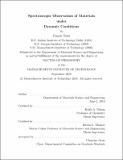Spectroscopic observation of materials under dynamic conditions
Author(s)
Saini, Gagan
DownloadFull printable version (17.29Mb)
Other Contributors
Massachusetts Institute of Technology. Department of Materials Science and Engineering.
Advisor
Keith A. Nelson and Edwin L. Thomas.
Terms of use
Metadata
Show full item recordAbstract
A new method is developed for direct real-time visualization of shock generation, propagation, and convergence in a sample. The approach opens up new possibilities for controlling the shock parameters and allows one to access pressures in the multiple gigapascal range. Optical generation of shock waves is followed by optical measurement of sample response during and after shock propagation. In this approach, a shock wave is generated that propagates laterally in the plane of the sample (perpendicular to the direction of the optical beam) rather than through the sample plane as in a more conventional approach. The optical configuration and sample geometry make shock wave formation and propagation directly accessible to optical imaging and spectroscopic probes with wavelengths ranging from UV to far-IR. With proper shaping of the optical shock generation pulse, focusing of the shock response can be initiated to provide increased shock pressure. The method has been validated through measurements of shock propagation in liquid water that illustrate some of the possibilities for shock generation, control, and measurement, and demonstrate the utility and potential of the new technique. The charge-coupled device (CCD) and streak camera images recorded provide for the first time a direct dynamic picture of cylindrical shock convergence within the nanosecond time window. This unique technique enables rapid and direct measurement of the dynamic shock responses of advanced materials and structures to diagnose and subsequently optimize their readiness in mitigating blast threats.
Description
Thesis: Ph. D., Massachusetts Institute of Technology, Department of Materials Science and Engineering, 2010. Cataloged from PDF version of thesis. Includes bibliographical references (pages 173-195).
Date issued
2010Department
Massachusetts Institute of Technology. Department of Materials Science and EngineeringPublisher
Massachusetts Institute of Technology
Keywords
Materials Science and Engineering.